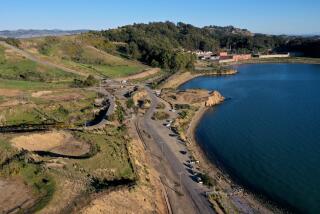Editorial: At the Los Angeles State Historic Park, a welcome sense of L.A.’s past and a needed whiff of fresh air
Los Angeles on Saturday marks Earth Day by opening vital green space in the city’s heart and, in so doing, reclaiming historic roots that for a century lay forgotten under freight yards and industrial pollution.
The new Los Angeles State Historic Park occupies acreage just north of Chinatown between the L.A. River and the Elysian Hills, where pobladores who journeyed from Mexico and later arrivals from Europe, Asia and the United States drew their water. It was where, beginning in 1876, a generation of migrants from points east ended their rail sojourns to California, disembarking at the Southern Pacific Railroad’s River Station. With the dawn of the 20th century, it was where the town became an industrial city as the depot, restaurants and hotels gave way to rail yards and switching stations. It became known as the Cornfields, although there was scant evidence that corn ever grew there.
Years later, when the railroad moved out, the city was left with a vacated and valuable swath of flat land that city leaders were ready to turn into a sterile expanse of warehouses. Fortunately, community activists and open-space advocates saw the land’s potential as the key link in a chain of green, open space that could one day run through the region alongside the river. The state came up with some money for a park, and after more than a decade of fits and starts — and an art project called Not a Cornfield (including an actual cornfield), plus a succession of music festivals — park development began in earnest three years ago.
Archaeologists using sonar discovered the buried foundations of the train station, the hotel, a roundhouse and other structures crucial to the growth of the city. The new park recaptures the civic memory of those historic buildings by tracing their outlines on the park grounds without infringing on the badly needed stretch of green.
Respect for history also requires L.A. to acknowledge that this is not the first Los Angeles State Historic Park. That distinction belongs to the area around Olvera Street, where the state, city and county tried to jointly manage a handful of historic structures and a somewhat kitschy Mexican marketplace. The arrangement largely failed, and the state pulled out two decades ago.
Now that the new state park is finally opening, let’s hope that it will have a smoother ride. It has enormous potential — to link the city’s burgeoning downtown residential population with the river, with the other former rail yards known as Taylor Yard and the Piggyback Yard, and with the rest of the region, both up and down the river, while providing a sense of history, some relief for the eye and a welcome whiff of fresh air.
Follow the Opinion section on Twitter @latimesopinion and Facebook
More to Read
A cure for the common opinion
Get thought-provoking perspectives with our weekly newsletter.
You may occasionally receive promotional content from the Los Angeles Times.










